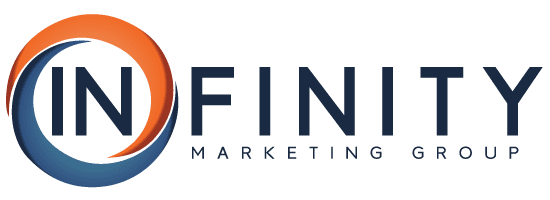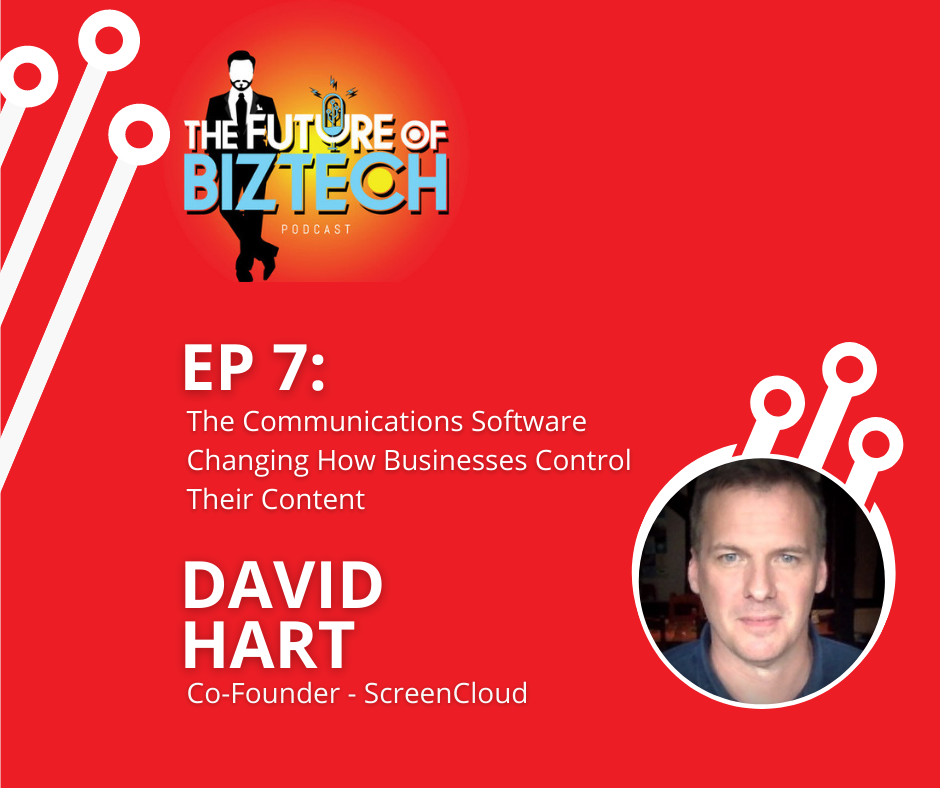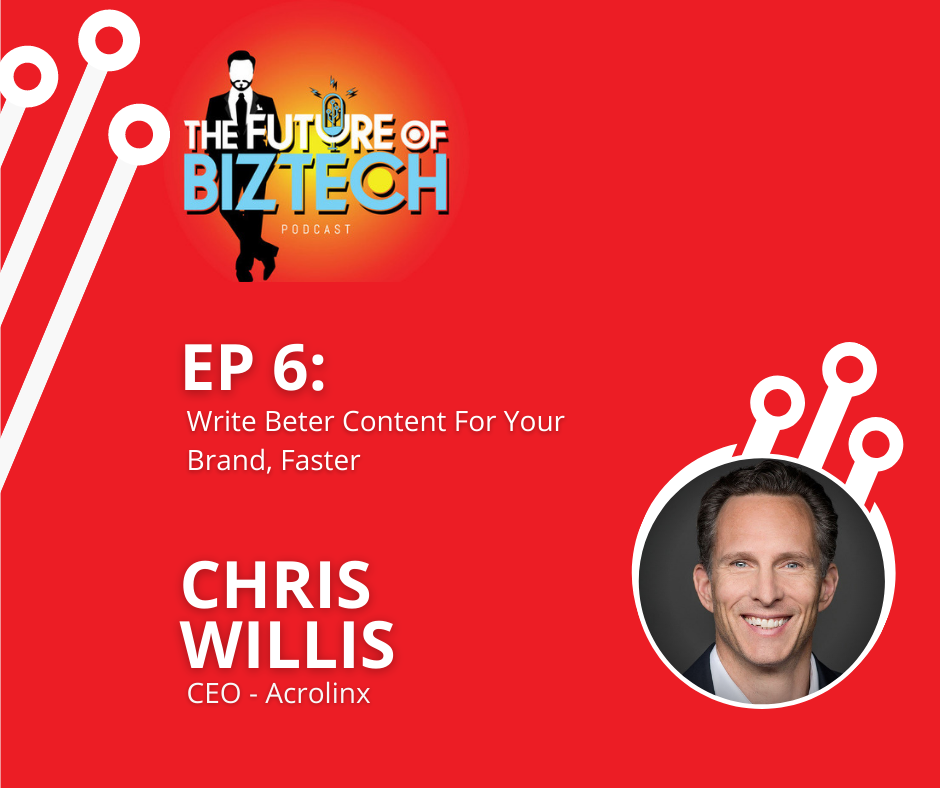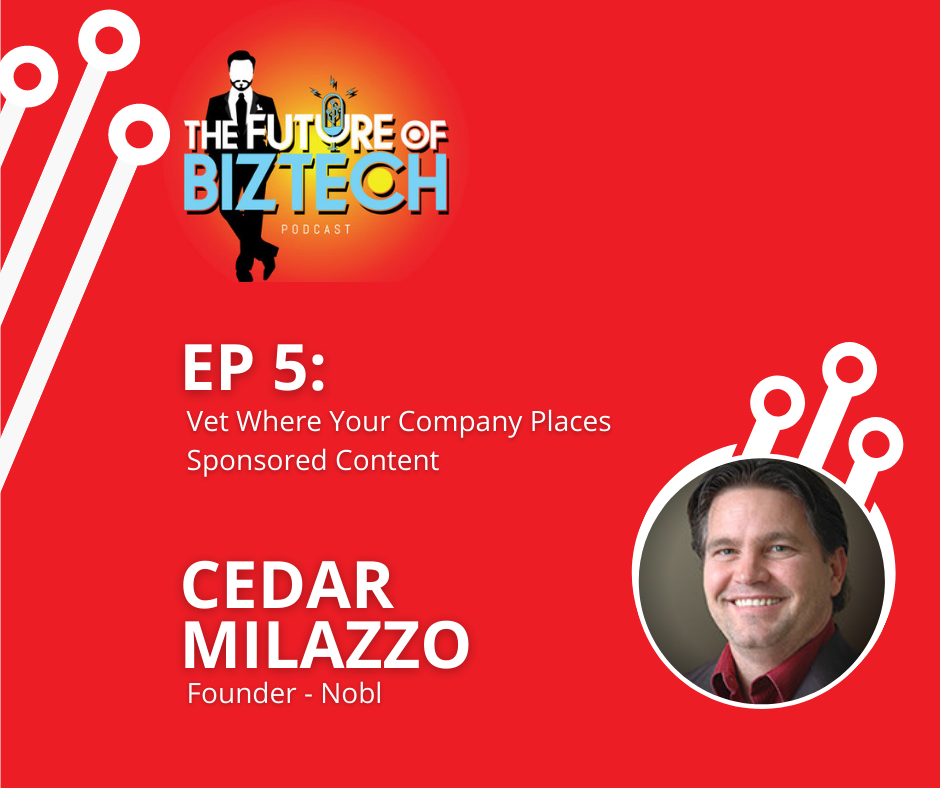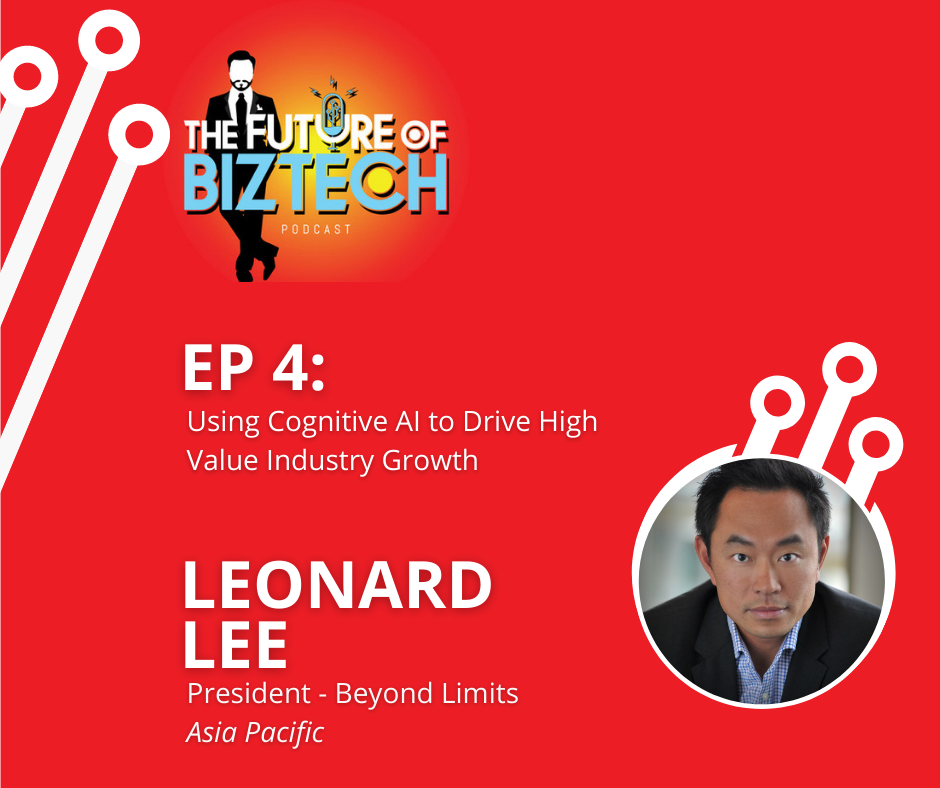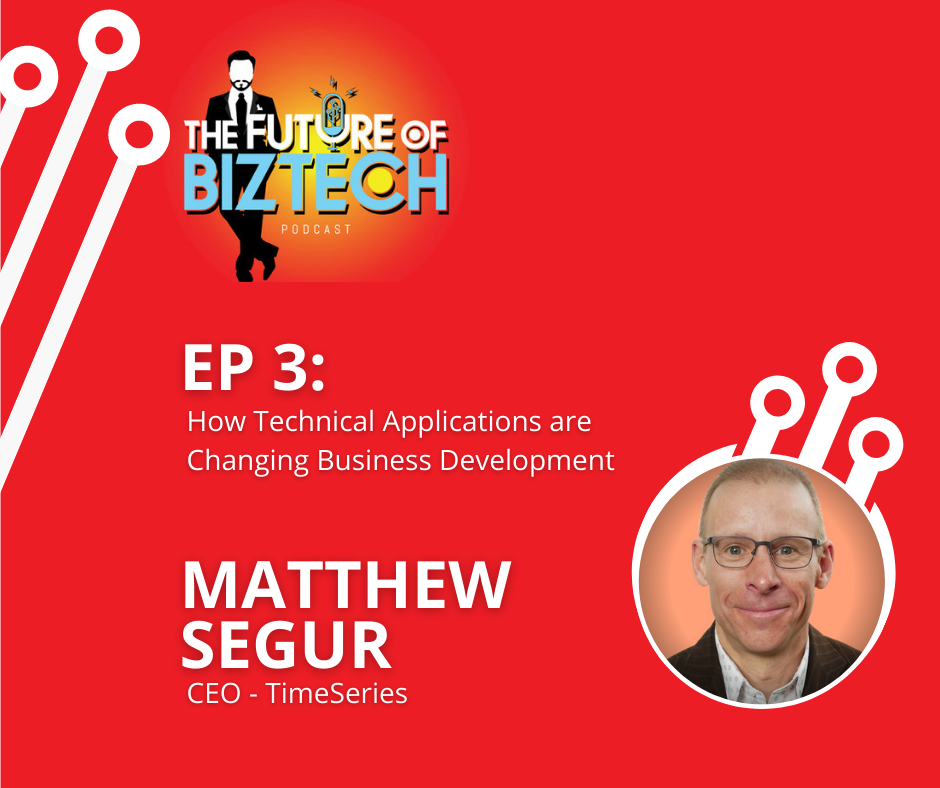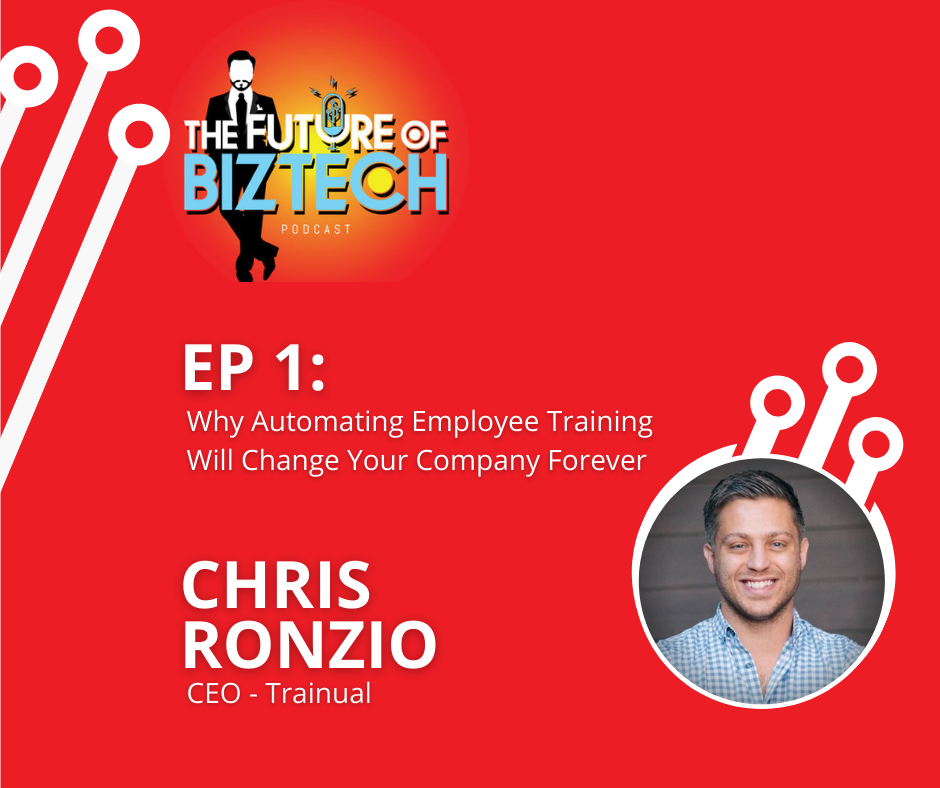Learn more about ScreenCloud at: https://screencloud.com/
Find David Hart on LinkedIn here: https://www.linkedin.com/in/davidhartxyz/
JC: Well, hello everybody, and welcome to another episode of The Future of BizTech. I’m your host, JC Granger. And I have with me here today, the co-founder and COO of ScreenCloud. And if you’re pulling it up on your computer, it’s screencloud.io. This is David Hart. David, thank you so much for coming on the show. Please introduce yourself to the audience and tell us a little bit about you and the company.
David: Thanks. Thanks for having me. So I’m David Hart. I’m one of the founders of ScreenCloud. And ScreenCloud is a software as a service business. We help companies, big and small, manage and create content on public screens using consumer devices. That was one of our USPs when we first started. So things like Amazon Fire TV Stick, or Chromecast or something like that, connects a normal screen and makes it a digital smart screen.
JC: That’s really cool. So I went on your website. I was watching your video on there, and what I found really interesting was it looked like if you had screens all over the world, you could manage them from your laptop basically. Is that correct? How does that work?
David: Exactly. So when we first started, we were talking to one company and they said that in order to update content on their screens in stores, they were having to courier DVDs out to the store managers and things like that. That was a long time ago, I guess. So effectively we’re like an operating system that works across different media players. So if your screen is smart and can connect to the internet, you can effectively run ScreenCloud and you can manage all the content, schedule it. You can say, “Well, this office has this content and this office has that content.” You can give people different permissions, you can publish content, and you can edit content, that kind of stuff. So really like a content management system.
JC: What clients are your biggest ones? I see in my head Reebok shoe stores and stuff or retail where they have things running on the screen. Are those the biggest clients you have, or is there other industries that I’m not even thinking about that have a use for this technology?
David: So retail is important, but actually, it’s not critically our most important factor. And I think that might be because they’re already pretty well catered for. So really digital signage came up in the audiovisual world. So they got into retail quite early. And when we came along relatively recently, we were like, “Hey, you don’t need these expensive proprietary bits of hardware. You can just use consumer hardware.” So what we found is we have got quite a lot of retail customers, but we’ve also got a lot of offices and critically deskless workers.
David: So if you’re working in manufacturing or health, education … And manufacturing could be literally in a warehouse or it could be chemical engineering, that sort of thing. So people that don’t necessarily sit in front of a desk all day, but still need to get that critical information across to them. That’s another big sector, but it’s-
JC: So like subway stations or government facilities or something like that where there’s a lot of information running constantly, maybe like train schedules? Do you see it seems like people are using it for more infrastructure practical purposes or do you see it more like marketing agencies running ads and being able to control those?
David: Strangely it’s not that many ads. So there are a few who do that, but it’s not so much used for that. We’ve got about 9,000 customers, and there’s a real variety of things. So on the retail side, it’s like digital menu billboards. If you go into like a fast food restaurant and they’ve got their menus up behind. So that’s all generated digitally. And the key thing is that it’s updated dynamically. So those prices, it’s not someone creating a JPEG and uploading it. Those prices are fed in through that ecosystem.
David: I think that’s probably where we’re slightly different from the traditional players. And the traditional players go, “Right. Here’s your hardware. Just make JPEGs and stick them up there, and they’ll look pretty.” What we’ve said is actually for lots of people, they don’t have someone sat there making videos and JPEGs, but what they do have is content that can be driven dynamically from their databases. So it could be pricing information, it could be sales data, anything really that people need to better do their jobs. So call centers might use them, for example, to show the volume of calls.
David: We’ve got a big internet company that’s constantly monitoring their traffic and the server loads that have those on their screens as well. So there’s a real mixture really of use cases, which is why we’ve got 80 plus different app integrations. So anything from your social media through to specific dash dashboards like Tableau or types of things that people are using day-to-day in their offices.
JC: So you told me one big pain point that your software solves, which is the old school way was literally having to courier DVDs or something. Is there anything else? I guess you said there is, but what else does this software really solve that wasn’t there before, other than having that manual upload situation?
David: There are lots of different types of use cases. So I guess the key thing to think about with digital signage is there is a passive communication module. It’s not like you actively go on … Let’s say you’re reading an email or you want to look at some sales data. You have to go on and log into something, look at your intranet or look at the dashboard. With screens, it’s much more of a passive experience. So what we’re finding is people are using it to connect either customers or each other with information that’s going on in the company.
David: It sounds a little bit obscured, but I’ll give you an example of a way which I suppose shows how companies can use screens to connect better with their end customers. So this is quite a simple example. So one of our customers manufactures houses on a conveyor belt. So they’ve got these teams of people and they’re working at each pool station, and they’re connecting houses together. And what they had before was screens just telling them that they’ve got 30 minutes left on their station and then it’s going to move on to the next thing. But what they realized was that they wanted to make people a little bit more connected with the customer.
David: So it’s, rather this abstract experience of, I’m just putting this screw on and using a wrench and doing it up, they were saying, “Well, we know who the customer is for each of these houses. We know where they live. And we probably know a little bit about them because selling a house is quite a sales intensive process. So they said, “Well, what if we use some quotes that we get from the sales team and the name and the location of the customer? And we can actually bring it to life. So rather than just working on a pool station, you’re seeing that you’re making this house for Mr. and Mrs. Brown and they live in Illinois and they’ve said that they’ve been saving up for 10 years, and this is their retirement home, and they’re going to live the rest of their day. Suddenly, that connection with the end-user is a lot more real. And it’s quite a small example, but it’s a way in which you use screens to bring things to life, using the data that companies already have. I think that’s where this is going. So typically or historically digital signage is really seen as just somewhere to put digital posters really. And now we’re seeing it much more as being, it’s real content that’s updated in real-time, dynamically. And it’s bringing to life and connecting things in a way that we couldn’t really do prior to this.
David: It’s not the same as having a mobile app or an email saying, “Hey, let’s have a look at your mobile app and see who you’re making this home for.” These people are working on factory lines. They’re not going to be firing up their mobile apps. It’s that kind of thing I think is where it’s going.
JC: You told me earlier in the pre-show that you started off as a consultancy. So how did you go from consultancy to a SaaS? That’s a pretty big leap. What was that turning point? What motivated you guys to make that shift and start ScreenCloud?
David: It’s a thing that a lot of people have asked us about, and effectively we were an agency, we were doing side projects. And we did a number of side projects. Some of them did okay. We sold a couple for a private equity company, and then we did a JV with someone else, and that got merged and bought and everything. So we’ve done okay, but we realized that they were all side projects. They would do, at their peak maybe … Well, apart from the one we did a JV on, which got quite large, but the side projects that we were doing, which were SaaS projects, and we did quite a lot of mobile apps and things like that. The most they ever got to was say maybe $30,000 a month in revenue.
David: So at the time we were going, “Well, if we just …” It’s only three of us, the founders. Obviously, we had staff, but we thought, what if we just keep doing that and just keep doing $30,000 a month things? It won’t take long before we can get rid of clients altogether, because anyone who works in a consultancy, clients, they’re hard work and you don’t get-
JC: Fire right now, all my agency for 10 years.
David: And it’s raining. And I remember coming back from Christmas. I’d been off. I came back and I realized that one of our apps had made more money over Christmas. I think it was the year that iPads came out. Everybody got an iPad for Christmas, and we had this amazing Christmas period. And I think our various apps generated more revenue than I paid myself for the whole year. I was like, “This is crazy.” We weren’t even at work and we were making this money. So we definitely got the bug.
David: We love the idea of having products, because the products that you produce, unlike when you’re working for clients and they always change what you do and go, “Oh, don’t do this,” and you’re like, “Oh.” And you just get paid for what you do, but with products, you get paid for the upside completely. And it’s all down to your efforts. So we made the decision for the three of us to do this. But I think the critical thing was we also made the really tough decision that if we were properly going to do this, it couldn’t be a side project, because we’d seen that all of our side projects had just stayed side projects.
David: Because actually launching a product takes a massive amount of energy and money and creativity and effort. And actually, if we were always going to have it as a side thing, the clients would always take price … The client was paying me $50,000 or a hundred thousand dollars for a project, then they’re screaming. You’re going to drop everything and sort it. So we made this decision and Mark and Luke, my two co-founders, went off to start the company full-time. And I was working on it part-time and I said, “Look, I’ll deal with everything else.”
David: So I basically sold the agency and extracted ourselves from our other commitments to the various … So I was doing a day a week for an ad tech company because we’d sold one of our apps to an ad tech company. I was doing a day a week on this JV we were doing. I was running the agency and I was trying to sell it without the founders. That was hard, and also trying to do some stuff on ScreenCloud. So it was really tricky. And then there was a moment where there was no going back. It was like, urgh. Meanwhile, ScreenCloud was growing like most SaaS companies do in the early days.
David: I think after about four months, it was doing say like $4,000 in revenue per month. And I was like, “Oh my God. We’re getting rid of this thing that pays for our mortgages and puts food on the table and putting all in this other thing that currently is only delivering $4,000 a month, and we had staff and everything.” So it was a pretty scary time, but god, I’m so glad we did it. It was the best thing we did, because-
JC: So how did you grow that? What kind of marketing or things did you guys do to grow the SaaS? Because we have a tech audience. I imagine some people listening have their own SaaS, whether it be in the startup phase or beyond. So what did you guys do marketing-wise, for example, or growth-wise, just in general to get it from $4,000 to where it’s at now?
David: So I guess the two things we did, one was an accident and one was deliberate. So the deliberate thing is that we invest in content right from the very, very start. So we were bootstrapping the business to start with, but then we raised some venture money. But what we did was made sure that we were working with someone that we knew pretty well who had worked with us before in our agency to write content for us. And we just said, “Right, just put out a load of content.” We were asking her to do four bits of content a week in two days, so she was just like a machine.
David: And we weren’t really writing about digital signage because we realized that a lot of the people who were buying digital signage or buying ScreenCloud hadn’t had it before. I probably should have mentioned this. This is the reason we built this in the first place, is because we wanted to show some stats on our wall, in the studio. And we said, “Oh, let’s go.” And the only way we could see that we could do it was to go with one of these expensive hardware manufacturers. There didn’t seem to be a software option, or at least not a software option where you didn’t have to invest in their proprietary hardware, either screens or the box that sat behind the screen.
David: So Luke, our CTO, hacked it and realized it was a little bit more complicated than he thought. So that’s why we thought of it as a product. So we really were just saying, look, let’s not write about digital signage because people aren’t really thinking about it in those terms. They’re thinking things like, I can stream things at home using my Chromecast. So why can’t I share my tweets on a screen in the office using a Chromecast? So we would just do loads of really long tail content, like how to show Twitter using an Amazon Fire TV Stick, or how to show Twitter on your screen. That kind of thing. How to connect to your Google Slides using a fire-
JC: That’s really smart, because you’re going to gobble up all that long tail keyword, traffic. Even though each one is maybe a ton of traffic in itself, you add it all up together and it becomes a good traffic. That’s pretty cool. How does this actually work? For example, to wrap my head around it, I sign up online, how do I add devices? How do I get it from the point where I’ve paid your company? I put my credit card in, and now how do I even do that? Do I have to download software to my smart TV? Is there a browser code? How does it get implemented on devices?
David: Exactly. So you get your fire TV stick. Let’s say, for example, you plug it into the back. You go to the app store on Amazon Fire-
JC: Is it just fire TV or is there other like Roku or Chromecast also?
David: Yeah. Chromecast. We’ve got loads of Intel devices as well. So they each have their own different ways of getting the app onto that. But let’s say the five TVs that you go on to the app store … And this is another way we got found, because none of the other incumbents were doing this. They were all doing this proprietary. So you bought the box, the software was already loaded on it. So if you went into Amazon Fire TV App Store and typed in digital signage, there was hardly anyone on there. So we were being found. That was the accidental way in which we grew. But you go on there, you download the app, ScreenCloud, download it to your TV stick and it comes up with the pairing code, which you will get from … So when you add a screen on the ScreenCloud in CMS, you press add screen and it’ll come up with a pairing code. You just type that parent code, and then that screen is then paired with that particular license on ScreenCloud.
David: And then that’s it. Basically, just start adding content. You can add apps, you can change the fonts, you can change the color palettes so it looks on brand. You can upload your own content. The whole thing was designed because we’re a UX web design agency, app development, we were coming at it completely from a software and UX perspective. Well, as I said, at the time … Lots of people have come in and done a similar thing now, but at the time, the incumbents were really selling the hardware and software as a bit of an afterthought. So the software was ugly. It didn’t work. It wasn’t very user intuitive.
David: So we just came in and just approached it from a completely different perspective. And we just found we were pushing on an open door. And then I think we did some research about two years in. So we’re five years old now. And I think 70% of our customers at that time had never had any digital signage before. So we were really opening up a new market. When we were going for funding in the early days, it was a real challenge because they were saying, “What’s the size of the software market for digital signage?” And you look at any of the Gartner or McKinsey reports, and it wasn’t that big.
David: It was because they were looking at the old world and how the old world might move, but actually now we’ve made it, it’s a lot more accessible. Anyone can do it. It’s 20 bucks per screen for a device. It’s nothing.
JC: That’s what I was going to ask. What price point is this? What’s the barrier to entry financially? Is it 20 bucks a month for every screen that you add to it basically?
David: Yeah. So one of the things that we realized two or so years in is that this was really an SMB product. And we were getting a lot of interest from enterprise, but then we were getting objections because we didn’t have SSO, or we didn’t have versus we didn’t have SOC 2. We didn’t have other security features around showing stuff that sat behind logins and all that stuff. So we rebuilt the product. This is another thing everyone said we were crazy to do, but we rebuilt the product. And so we’ve now got different tiers, so if you need all of those bells and whistles, the entry price point is 20 bucks per screen per month, but it does get more expensive if you want some of the other enterprise features.
JC: If you’re enterprise and you have that needs, you expect to pay more, but that’s a pretty great price point, honestly. And there’s no minimum, right? If I wanted to go on there and just put in one screen, I can just do one screen, right?
David: Yep.
JC: That’s fine. Well, here’s what I like about your software, especially with COVID right now and then everyone going remote, I see this having a bigger need right now, because you can have a situation where you’d have people … For example, you could even say, “Hey, if a person’s working remote, say, okay, well on your TV, I’m going to …” For employees or staff, possibly, even for remote workers buying a computer, you could say, “Well, we’re going to put the software on your TV so that you can see these things while you’re working, because we need you to see these live updates.” I could see that being a thing, right?
David: Yeah.
JC: I think this is a really interesting concept and just software you have here, because you’re looking at it from, the people bought it right now, and you were saying all these manufacturing places or things like that, and that’s all great. But I also see potential here for people who just work from home because they’re remote. Maybe salespeople. You could have a whole remote sales team, for example, working from their computers. And if you put this on their screens, they could see where the sales numbers are or territories or just live updates that you want them to have during their Workday. And then at the end of the day they just turn it off, they turn the channel. Simple enough.
JC: So I could see that being integrated as well, experimentally. And I think that’s just such a cool concept, which actually brings me to my next question, which is where do you see the future of this going? The title of the podcast is The Future of BizTech. So where do you see this going in five years, for example, with how things are changing? If you had to guess, where is it going?
David: Well, I think there’s two things. I think you’re actually spot on because the future of work is going to be a mixture of remote and going into the office. And we’ve started working with this thing, we’re calling it embeddable channels or virtual screens, but it’s effectively a virtual screen cap that you can look up on a browser, but it’s slightly different the way it’s laid out. But you can even look at it on a browser or you could embed it into your intranet or something like that. But the other thing that we’re doing is we’re thinking of it like Netflix for work.
David: So going back to this idea, let’s say in the morning, you’re working from home and you do catch-up like you would with Netflix. So you might just go into the ScreenCloud app and the normal screen is like a passive experience. Someone schedules it or it’s scheduled and it changes and you don’t interact with it. You just go, “Oh yeah, that’s cool.” Whereas with this, it’s much more of, “I’m going to look in here, and I’m looking at the marketing channel,” let’s say. So you’ve got different channels and I’m going to go, “Click. That’s interesting. I’m going to watch that. This is a little video they’ve done about a particular campaign. Brilliant.”
David: There’s a message from the CEO. I’m going to look at that, and “Oh, I’ve only got five more minutes, so I’m just going to quickly look at the sales numbers and then I’m going to go off and do my first meeting.” So I think probably an element like that. So we really see digital signage as I said, moving from this idea of digital posters to something that becomes much more rules-based. And that could be written rules that someone creates, or it could be learned rules through AI. So it’s like, if you think about at the moment in the workplace, we’re surrounded by loads of messaging, we’re all using Slack or Teams. We’re doing Zoom videos, Loom videos. It’s just constant.
David: So how do you make sense of that? How do you surface that content? And I think that could be done either by someone writing rules. So they say, “Well, look, these kinds of information we think is really important. We’re going to show that,” but it could also be some AI stuff. So let’s say, for example, you’re saying about sales figures. You’ve got a dashboard that’s showing – what happens if the system is working out what is normal and what isn’t normal? So it’s looking at your dashboard. And again, bearing in mind the screens there, it’s not in front of you. It’s something that’s kind of there. What if it notices something that’s out of the ordinary?
David: So it goes, “Normally you have churn of 1% a month or something. It’s jumped up to 10% this month. The system should be able to work out that this looks really, really unusual and surface that content perhaps more than some of the other content.
JC: You’re going to have an AI aspect to this. If you’re looking at a smart system that can actually not just serve the content you want but serve content that needs, that should be seen based on that machine learning of it.
David: I think that’s where I was going, because-
JC: And I like the browser idea, because that’s also really cool, because people usually have multiple screens anyways, especially working remote and you get a tab open, for example, that’s just your company tab browser in just Google Chrome. Because you have a plugin obviously or you just create a plugin on there and all of a sudden it’s like, if I want to serve this screen to all my staff, if they click on that tab, they can see what everyone needs to see at that moment. As a CEO who has remote workers … A lot of my people are here in Denver, because we had an office, but then with COVID, well, we don’t have an office anymore.
JC: So now we’re starting to hire people around the nation just because it’s a bigger talent pool. We can get the best of the best when you can work outside of your location. And so this software really interests me from that point of view, especially if you come out with that browser version, because I’m like, there are some things that I want everyone to be able to see pretty much ongoing or reference. And if I could create that … If you had a plugin where I could log into that and I could just serve it to all their screens, that’s super cool and very huge when it comes to communication. Even a training point as well.
David: We’ve got some of our customers who have created their own company TV, which is exactly that. And the nice thing as well is that you can have content scheduled and some of it can be dynamic. It can be pulled through social media stuff or it could be pulling through data, but then if you want to, you can take it over and you can do a live broadcast. So you can cast directly. You can literally just go, “Hey, everyone.” Press a button and then suddenly you’re there and you’re saying … And then when you stop, it goes back. So no, you don’t need to reset it or anything.
David: So we did our first all-hands the other day using this new technology. It’s using some of the technology from Twitch actually. So when you do a Zoom cast to all of your company, it’s fine if there’s a few of you, but we’re nearly a hundred people now, so it’s quite cumbersome. And if you are a thousand or 10,000 people, it just becomes really difficult. So with this, you just live cast and whoever has got the mic at the time speaks to the whole company. You just stop at the end.
JC: You know what this could be cool for, something that just came to mind … And you probably already thought about this, but something that I just wanted to talk about. So before COVID, we were registered for multiple conferences and obviously conferences got shut down and went away. They’re rescheduling for 2021, but what I’m starting to see is this uptick in these smaller virtual conference-style settings. But there’s a limitation to that when it’s based on attendance in that Zoom meeting style. There are only so many people we could put on this before it became too distracting. But what I think is interesting about your technology is I envision this situation where you could have a virtual conference, but because everything was streaming onto people’s screens, you really can now watch this person give their speech in that more live interactive way where sometimes these video conferences fall short.
JC: And I think that’s interesting, because there are certain things you’re not going to ever be able to replace a conference with. The whole point of conferences was that in-person interaction. But that being said, when you’re forced to adapt and overcome, it seems like your software could take a big role in conference companies to try to figure out a way to use that and get it onto people’s screens in their homes. Watching it on your TV is different than watching it on your screen at your computer. Because a lot of people have maybe 13 or 15-inch laptop screens, whereas TVs are 45 to 60, 70 inches big.
JC: And so having that more interaction in that sense and watching a keynote speaker from your TV versus your smaller laptop, that really changes the experience. And I feel like what you’re doing could help with that too.
David: That’d be quite nice, because you could have your Slide or whatever on your laptop, but the main stage is your main …
JC: Look at that. I’m giving you ideas.
David: No, no.
JC: You got a new industry to go after now. We’ll talk about it later. All right. A couple of personal questions for you. And I ask this about every guest. When you were a kid, what did you want to do when you grew up, and then how did it transition to what you’re doing now?
David: So I wanted to be either an artist or a rock-and-roll star, I think.
JC: Kind of the same.
David: I just thought, you know what, I’m going to be doing something creative. It will be fine. I don’t have to worry about anything else. I don’t know. How did it really translate? I almost went to college to do art and then I had a change of heart and went and did economics and politics and philosophy and started working in publishing. Worked for The Economist magazine and then got into some digital and then got into an agency. So I think though, the one thing that’s probably been constant is I always imagined that I would have my own business. I think that’s partly because I’ve never been very good at being told what to do. I think a lot of people who run their own business go, “Oh, no one would employ me.”
JC: I was like, “Oh yeah, speaking to the choir,” right?
David: Yeah. That’s probably the only thing that, I guess, links back is definitely a desire to do things my own way. And not because I wanted to rule the world or own lots of money or anything. I think it’s just for my own-
JC: That freedom to express, right?
David: Yeah. What I love as well is if things go well, you benefit. If things go badly, then you don’t. But if you work for a company, if things go well, you still get paid whether it goes well or bad. You might get a commission or whatever, but I love the fact that if you do a really, really good job and you work really hard and you try your best, in theory, you get some reward down the line.
JC: You can control your own destiny in a way, right? You’re either your best friend or your own worst enemy, but it’s all on you at least. That’s how I feel.
David: And I love the things where you’re constantly learning. We’ve got brilliant investors and we’ve learned so much from them. Starting my first business in 2004, you’d think I’ve seen everything, but there’s so much more that we have to learn about. And I just hired a new VP of sales in LA and a VP of marketing. And again, there’s so much stuff that they know that I don’t know. And I just love that. I love that constantly learning more about things to do with the businesses. I think-
JC: That’s awesome. So last personal question. Who is one of your mentors business-wise, or even maybe just personal growing up, and then what’s the best piece of advice that you’ve ever been given business-wise?
David: Oh, man.
JC: People know that I just spring this on you, because it’s not an easy question.
David: Well, at the moment, we’re thinking about a new category, because I’ve been talking about digital signage and we’re realizing that we’re going to move into a new category. So there’s a really good book, Play Bigger, and it’s all about creating a new category and the reason for doing that and why it’s such a good thing to do. And it’s so relevant for where we are right now, because I think ever since we started, we’ve always felt like a bit of an outsider in the digital signage industry. We used to go to conferences and it’d just be full of men in gray suits, selling screens, and pixels, and bevel edges and cabling. And they were like, “You guys with your little software thing over there.”
David: So we’ve always felt like the outsider, but I think creating … All the things I was saying about how we think digital signage is going to go in the future, I think we want to define it and own some category. So that’s my influence at the moment. But I’m thinking a lot about this and these guys and what they’ve done. And people like the Drift characters, they created that category, conversational marketing, which they could have just written a book about chatbots, but instead, they talked about conversational marketing, and they created a category. And I think that’s really amazing. Oh man. Best piece of advice. I know I’ve got some, but I can’t-
JC: Listen, the book itself, like even just recommending the book, that’s good advice. I was over here writing down the title of the book here too because I want to read it now. So if there’s that one-liner you can think of, then that’s awesome. If not, even just the audience knowing about that book, it seems pretty inspirational to you.
David: I suppose it’s a specific piece of advice, but the whole thing around SaaS is there is a playbook. So quite often in businesses, we’re constantly trying to reinvent things. But one of the things I realized … And again, this is what our investor said to us. He’s like, “Okay, SaaS is quite a relatively new industry in the grand scheme of things compared to mechanical inched motor cars or something like that. SaaS is quite a recent thing, but there’s a lot that’s been written about it, and there’s a lot of data and stuff that you can follow and people behave in a largely predictable way.
David: So understanding that and taking confidence from that. When things first started with SaaS, as I was saying earlier, we were going four or five months and we were still only doing $4,000 in revenue, which when we started our agency, we were doing $40,000 within two or three months. And it took us 22 months to get to our first million dollars in revenue, and then another six months to double that. And that was the thing. It’s like if you look at the playbook, you understand what you’re doing and understand all the metrics you realize that you just gotta put faith in it. You go, “Okay, well, I can see that this stuff takes a long time to build, but then it starts a real rollercoaster.” And that gets super exciting.
David: So I guess my one piece of advice that was useful certainly from our investors is don’t forget that there are lots of people who’ve done this before who’ve done it really, really well, and you don’t have to reinvent it each time. You can obviously put your own spin on it, but seek out that wisdom and use it to your advantage.
JC: That’s great advice. Listen, the last thing here is how can people reach you or the website? If there’s anyone listening, who wants to reach out to you directly, what’s the best way for them to do that? And then also remind people about your web address and how, if they’re interested in your product, what they should do as well.
David: Well, actually we bought the dot-com, and so you can do screencloud.com or screencloud.io or screen.cloud. We’ve got all of those, but anything ScreenCloud, you’ll find us. And then if you want to talk to me, probably the best thing is to connect with me through Twitter, because it’s easy to remember. And if you just message me there, it’s @DavidHart, H-A-R-T, or look me up on LinkedIn, that kind of thing. I love talking about all of this stuff, especially the transition from agency to product company, because I’ve done a few talks on it and people come up to me afterward and go, “Oh my god, I’m exactly at the point where you were before you made the decision and we’re just wrestling with this ourselves.” So I know that it’s a rich vein that people are potentially interested in.
JC: No, absolutely. Well, listen, thank you so much for being on the show. You’ve given the audience a ton to think about. And I hope people go to screencloud.io or screencloud.com, check it out. I was there earlier, watched the video, looks amazing. I’m really looking forward to seeing those new things you were talking about, like the browser version. That would be really huge. So I wish you well in all that, and thanks again for being on the show.
David: Well, thank you.
